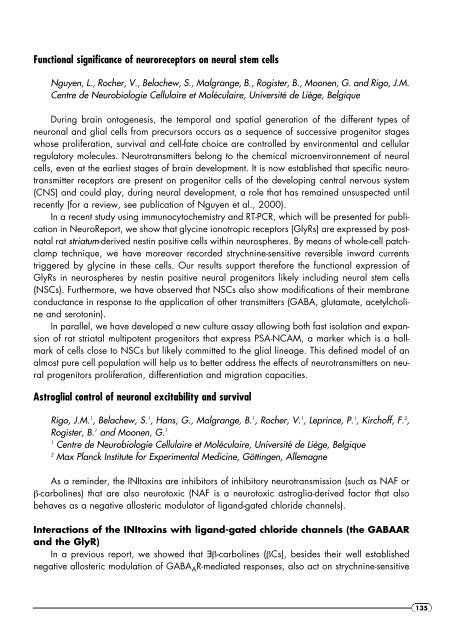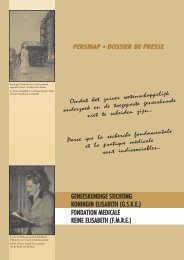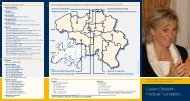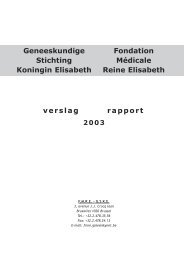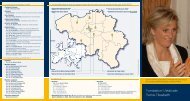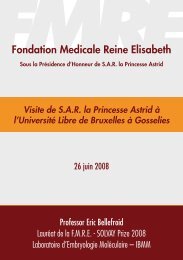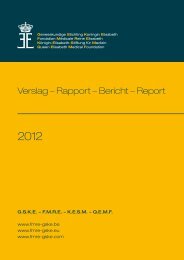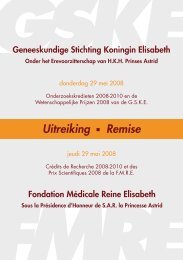Geneeskundige Stichting Koningin Elisabeth ... - GSKE - FMRE
Geneeskundige Stichting Koningin Elisabeth ... - GSKE - FMRE
Geneeskundige Stichting Koningin Elisabeth ... - GSKE - FMRE
You also want an ePaper? Increase the reach of your titles
YUMPU automatically turns print PDFs into web optimized ePapers that Google loves.
Functional significance of neuroreceptors on neural stem cells<br />
Nguyen, L., Rocher, V., Belachew, S., Malgrange, B., Rogister, B., Moonen, G. and Rigo, J.M.<br />
Centre de Neurobiologie Cellulaire et Moléculaire, Université de Liège, Belgique<br />
During brain ontogenesis, the temporal and spatial generation of the different types of<br />
neuronal and glial cells from precursors occurs as a sequence of successive progenitor stages<br />
whose proliferation, survival and cell-fate choice are controlled by environmental and cellular<br />
regulatory molecules. Neurotransmitters belong to the chemical microenvironnement of neural<br />
cells, even at the earliest stages of brain development. It is now established that specific neurotransmitter<br />
receptors are present on progenitor cells of the developing central nervous system<br />
(CNS) and could play, during neural development, a role that has remained unsuspected until<br />
recently (for a review, see publication of Nguyen et al., 2000).<br />
In a recent study using immunocytochemistry and RT-PCR, which will be presented for publication<br />
in NeuroReport, we show that glycine ionotropic receptors (GlyRs) are expressed by postnatal<br />
rat striatum-derived nestin positive cells within neurospheres. By means of whole-cell patchclamp<br />
technique, we have moreover recorded strychnine-sensitive reversible inward currents<br />
triggered by glycine in these cells. Our results support therefore the functional expression of<br />
GlyRs in neurospheres by nestin positive neural progenitors likely including neural stem cells<br />
(NSCs). Furthermore, we have observed that NSCs also show modifications of their membrane<br />
conductance in response to the application of other transmitters (GABA, glutamate, acetylcholine<br />
and serotonin).<br />
In parallel, we have developed a new culture assay allowing both fast isolation and expansion<br />
of rat striatal multipotent progenitors that express PSA-NCAM, a marker which is a hallmark<br />
of cells close to NSCs but likely committed to the glial lineage. This defined model of an<br />
almost pure cell population will help us to better address the effects of neurotransmitters on neural<br />
progenitors proliferation, differentiation and migration capacities.<br />
Astroglial control of neuronal excitability and survival<br />
Rigo, J.M. 1 , Belachew, S. 1 , Hans, G., Malgrange, B. 1 , Rocher, V. 1 , Leprince, P. 1 , Kirchoff, F. 2 ,<br />
Rogister, B. 1 and Moonen, G. 1<br />
1 Centre de Neurobiologie Cellulaire et Moléculaire, Université de Liège, Belgique<br />
2 Max Planck Institute for Experimental Medicine, Göttingen, Allemagne<br />
As a reminder, the INItoxins are inhibitors of inhibitory neurotransmission (such as NAF or<br />
β-carbolines) that are also neurotoxic (NAF is a neurotoxic astroglia-derived factor that also<br />
behaves as a negative allosteric modulator of ligand-gated chloride channels).<br />
Interactions of the INItoxins with ligand-gated chloride channels (the GABAAR<br />
and the GlyR)<br />
In a previous report, we showed that ∃β-carbolines (βCs), besides their well established<br />
negative allosteric modulation of GABA AR-mediated responses, also act on strychnine-sensitive<br />
135


